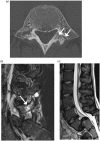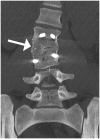Back pain and scoliosis in children: When to image, what to consider
- PMID: 28786774
- PMCID: PMC5602330
- DOI: 10.1177/1971400917697503
Back pain and scoliosis in children: When to image, what to consider
Abstract
Back pain and scoliosis in children most commonly present as benign and self-limited entities. However, persistent back pain and/or progressive scoliosis should always be taken seriously in children. Dedicated diagnostic work-up should exclude etiologies that may result in significant morbidity. Clinical evaluation and management require a comprehensive history and physical and neurological examination. A correct imaging approach is important to define a clear diagnosis and should be reserved for children with persistent symptoms or concerning clinical and laboratory findings. This article reviews the role of different imaging techniques in the diagnostic approach to back pain and scoliosis, and offers a comprehensive review of the main imaging findings associated with common and uncommon causes of back pain and scoliosis in the pediatric population.
Keywords: Back pain; CT; MR; imaging; infectious diseases; radiographs; scoliosis; spinal tumors; spine; spine dysraphism; spondylolysis; trauma.
Figures












References
-
- Altaf F, Heran MK, Wilson LF. Back pain in children and adolescents. Bone Joint J 2014; 96-B: 717–723. - PubMed
-
- Slipman CW, Patel RK, Botwin K, et al. epidemiology of spine tumors presenting to musculoskeletal physiatrists. Arch Phys Med Rehabil 2003; 84: 492–495. - PubMed
-
- Bernstein RM, Cozen H. Evaluation of back pain in children and adolescents. Am Fam Physician 2007; 76: 1669–1676. - PubMed
-
- Kjaer P, Leboeuf-Yde C, Sorensen JS, et al. An epidemiologic study of MRI and low back pain in 13-year-old children. Spine 2005; 30: 798–806. - PubMed
-
- Jackson C, McLaughlin K, Teti B. Back pain in children: a holistic approach to diagnosis and management. J Pediatr Health Care 2011; 25: 284–293. - PubMed
Publication types
MeSH terms
LinkOut - more resources
Full Text Sources
Other Literature Sources
Medical

